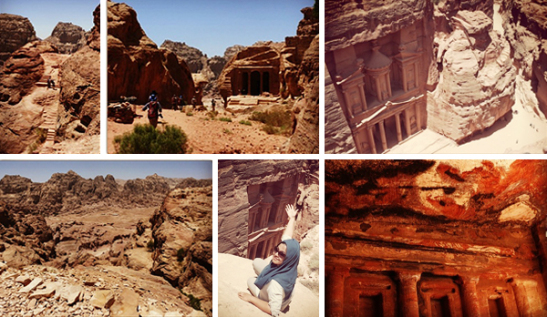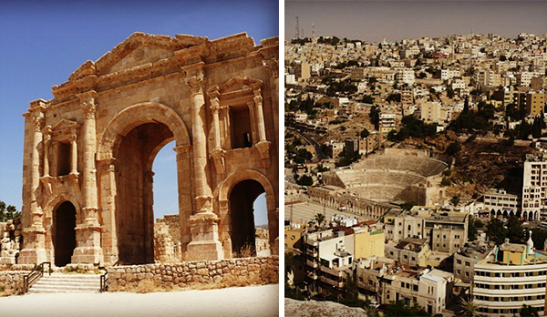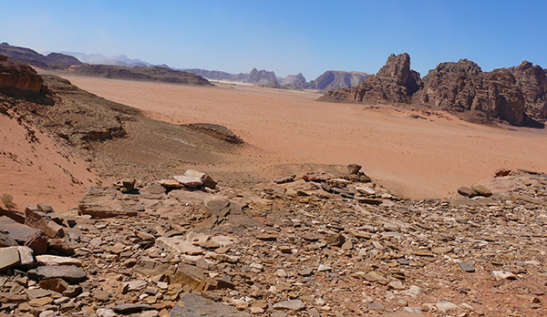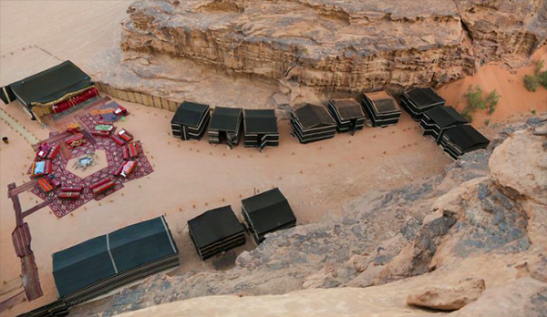
If a picture is worth a thousand words, then experiencing something in real life has got to be worth an entire library. Standing in front of the Treasury in Petra, Jordan, this statement made perfect sense to me.
From postcard pictures to live action scenes of Indiana Jones, images of the most famous fixture at Petra are a common sight to even those who’ve never set foot in Jordan.
Despite studying endless photos of this marvel in detail, seeing the famous 1st century royal tomb in person took my breath away. Everything about this decorative cave carved into a rose-coloured mountainside was impressive. The façade popped out of a rugged cliff like a perfectly inked pattern cut into the blotchy base of a rubber stamp. Its design had complete architectural symmetry and impeccable detail. The smooth, slender columns were topped with leafy decorations in the classic Greek Corinthian style. A triangular pediment crowned the doorway, and tiny square blocks lined the dentil style moulding of the roofline. Every detail was so precise it looked as though it was cut with a laser. In fact, if it weren’t for the extremely weathered sculptures that decorated the front, you would think the Treasury was built just yesterday.

Although it is massive – measuring 30 metres wide and 43 metres tall – the Treasury seemed small next to the towering cliffs that surround it, closing over it like cupped hands sheltering a candle’s flame.
The space in front of the Treasury was busy, like a city square, with pedestrian and donkey traffic flowing in and out. Despite the hustle and bustle, standing in front of this great monument was a peaceful experience. The chatter in English, Arabic and in languages from around the world blended together in a soft hum. Tourists visiting the Eiffel tower often cheer with excitement but everyone that stood in front of the Treasury seemed to have their breath just taken away.
It takes about 15 minutes to walk from the main entrance of Petra through a beautiful slot canyon to get to the Treasury. And you’ve only seen the tip of the iceberg so far. I spent my day at Petra on a 3-hour off-the-beaten-path guided hike that took our group through boulder-filled canyons and high up into the mountains for a peek at the Treasury from above before heading back down to see it from the ground. You can spend days exploring all of the sites at Petra, but if you only have one day this map helps you focus your trip on the highlights.

Although Petra may be the primary draw for visitors travelling to Jordan, it definitely isn’t the only thing to see here. For a country that’s just slightly larger than New Brunswick, Jordan’s landscape – and the experiences offered – are vast and varied.
History buffs can get their fix by visiting the ancient city of Jerash in the northern part of Jordan. Dubbed “the Crossroads of Civilization”, Jerash was occupied through time by many great civilizations – the Greeks, Romans, Byzantine, and Umayyad – all of whom left their mark. The most notable site here is Ancient Jerash where you can walk through one of the best-preserved Roman cities.

Just an hour away, the capital city of Amman is a place where it is possible to stroll through ancient monuments and modern fixtures all in one day. In the morning, you can walk through the 2,000-year-old Temple of Hercules, and the 7th century Umayyad mosque at the Citadel, view some of the Dead Sea Scrolls which date back to 400 BCE at the Archeology Museum, before heading to the Souk Jara to shop for handy crafts made by locals living there today.
Nature lovers can choose to indulge is several types of landscape all packed into a tiny country. Take in the wetland oasis of the Azraq Reserve, the greenery of the Dibeen Forest Reserve, the rugged mountains and canyons of the Dana Biosphere Reserve, the underwater treasures of Aqaba and the Red Sea, or the enchanting wonder of floating in the Dead Sea.
The real magic, however, happens in the desert Wadi Rum.
Visiting a desert for the first time, what I expected to see was a dull and monotonous span of sand dunes from one end of the horizon to the other. I thought we would walk among the alien landscape amazed at first, but after about an hour when boredom set in, we would seek to return to civilization. This couldn’t be farther from the truth since my actual experience made me want to stay at Wadi Rum forever.

The landscape was anything but dull and monotonous. The sand that stretched for miles and miles was a beautiful shade of rosy pink, making the scenery look delicate rather than rugged. And it was soft. So soft that I literally felt like kicking off my shoes and lying face down to feel it against my skin.
In some of the flatter areas, the push and pull of the wind caused the sand to ripple beautifully in striped patterns. In other areas, a layer of rocks covered the smooth sand like chocolate chunks on top of creamy raspberry-chocolate ice cream. Giant sandstone formations rose up from the desert in all directions. From a distance they looked like big mounds of crunchy English toffee. When viewed up close, the many layers of shaded sediment gave the formations the look of sand art.
You could explore Wadi Rum the most authentic way with a Bedouin guide, travelling on camels or on foot. But we took the slightly lazier method and spent the afternoon driving around various parts of the desert in the back of a 4WD jeep. Still, our guides were local Bedouin since only they are able to navigate the desert without the aid of a mapping device.
First stop was the site of the red sand dunes, a steep mound of bright rose-coloured sand wedged against a beautiful sandstone formation. You can try and run up the sand dune (it’s harder than it looks!) or you can scramble your way up the red rock. Either route will bring you to a high point where a breathtaking view awaits. On the way back down you can run, slide or even roll in the silky soft sand to the bottom of the dune.

Next stop was the Jabal Umm Fruth Rock Bridge, the most beautiful of the several naturally occurring rock bridges in the desert. The Jabal Umm Fruth is 15 metres tall and forms a stunning arch. It takes only about five minutes (and basic skill) to climb to the top of the arch for a great photo op and an even greater view of the surrounding desert.

You can also explore Wadi Rum on a guided hiking tour or by booking a romantic hot air balloon ride. All excursions can be arranged with the Captain’s Tourist services.
A trip to Wadi Rum would never be complete without experiencing a desert sunset – the perfect way to end the day. And that’s exactly what we did next.
As the sun slowly began to set, the reddish orange hue of the sand began to deepen into an intense copper, and the red rock mounds became caramel brown. Getting back into the jeep, we made a mad dash towards another viewpoint trying to catch the sun before it set. We made it there just in time to see it slowly waltzing towards the horizon. Up close, the shadows grew longer making every rock, every detail appear more defined. Farther in the distance, the shapes of the rocky mounds faded into ghostly silhouettes. As each minute passed, the colour of the desert intensified climaxing at the point when the sun met the horizon. Then, as the brilliant golden disc of light tucked itself under the earth’s blanket, the blazing pigments of the copper-coloured desert drifted slowly into a deep, still sleep.

That night, we slept in the desert too. We drove to the Captain’s Camp just in time for dinner. On the menu was an authentic zarb feast – meat and vegetables slow baked under the sand. The flavours mixed together in a smoky medley, the meat was tender and the vegetables were caramelized to a nutty perfection. As we ate, we were entertained by local musicians performing traditional Bedouin music. Once we finished eating, they pulled us out of our seats and taught us a social dance. We held hands and danced around the bonfire. We clapped to the beat of the song, kicked our legs left and right, and bobbed our heads to the beat of the music. It felt as though we had been transported into a completely different world, not a skyscraper nor a light bulb in sight. And we were loving it.
Eventually the music began to slow down, signaling bedtime. The fire was put out and everyone retreated to their tent – a luxurious version of an authentic Bedouin style tent made from patches of woven goat hair. As nice as it looked, a few of us chose to sleep under the stars instead.

I burrowed under a thick blanket attempting to keep the cold desert breeze out. It kept me awake for most of the night, but I wasn’t complaining. Even the moon realized I wasn’t going to sleep much that night so it rose up, high in the sky, to keep me company.
I thought of nothing but the beauty of the night’s sky; the stillness; the sound of the sand being blown by the wind; and the smell of the clean, dry air. The skin on my face felt tight and no matter how hard I tried that giant, stupid smile wouldn’t leave. But how can I blame it. Lying there beneath the stars, in the middle of the Wadi Rum desert half way across the world, I didn’t want to leave either.
Leave a Reply